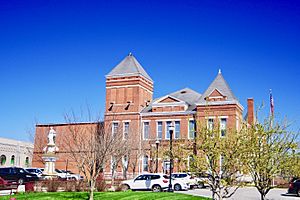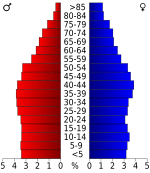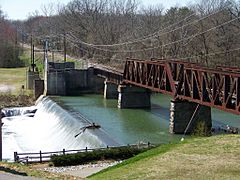Warren County, Tennessee facts for kids
Quick facts for kids
Warren County
|
||
|---|---|---|

Warren County Courthouse in McMinnville
|
||
|
||

Location within the U.S. state of Tennessee
|
||
 Tennessee's location within the U.S. |
||
| Country | ||
| State | ||
| Founded | 1807 | |
| Named for | Joseph Warren | |
| Seat | McMinnville | |
| Largest city | McMinnville | |
| Area | ||
| • Total | 434 sq mi (1,120 km2) | |
| • Land | 433 sq mi (1,120 km2) | |
| • Water | 1.4 sq mi (4 km2) 3%% | |
| Population
(2020)
|
||
| • Total | 40,953 |
|
| • Density | 92/sq mi (36/km2) | |
| Time zone | UTC−6 (Central) | |
| • Summer (DST) | UTC−5 (CDT) | |
| Congressional districts | 4th, 6th | |
Warren County is a county located on the Cumberland Plateau in Middle Tennessee, one of the three Grand Divisions of the U.S. state of Tennessee. As of the 2020 census, the population was 40,953. Its county seat is McMinnville. Warren County comprises the McMinnville, TN Micropolitan Statistical Area.
Contents
History
Warren County was created in 1807 from a portion of White County, and named for Joseph Warren (1741–1775), a militiaman and major general in the American Revolution. The revised Tennessee State Constitution of 1834 stated that no new county could be within 12 miles (19 km) of the county seat of the county from which it was formed. The boundaries of five counties formed from Warren— Grundy, Van Buren, Cannon, Coffee and DeKalb— were exactly 12 miles from Warren's county seat, McMinnville, giving the county its distinctive round shape. Warren County was the site of several saltpeter mines. Saltpeter is the main ingredient of gunpowder and was obtained by leaching the earth from several local caves. Hubbards Cave, near Camp Woodlee, was a major operation. Henshaw Cave on Cardwell Mountain (now part of Cumberland Caverns) and Solomon Saltpeter Cave on Ben Lomond Mountain were relatively small mining operations. Most saltpeter mining occurred during the War of 1812 and in the Civil War.
The county was largely developed for farming of such crops as tobacco and hemp. While numerous families held enslaved African Americans as workers, they were a minority of the population. Warren County citizens voted to secede from the Union before the American War Between the States in February 1861 in a state referendum. Voters in Tennessee overall decided to remain in the Union in that time. When President Abraham Lincoln demanded that Tennessee provide troops to fight against the Southern states in April 1861, it was viewed as a violation of Article 3, Section 3 of the U.S. Constitution. At a new referendum in June 1861, Warren County again, along with a majority of Tennessee's counties, voted for secession. Unlike in some states, slavery was not listed as one of the reasons in Tennessee's secession proclamation.
Men from Warren County and surrounding upper Cumberland region formed and served in many units in Tennessee's defense, including the 16th Tennessee Infantry led by McMinnville resident Col. John Houston Savage. The Confederate monument next to the county courthouse is dedicated in the memory of the men who served and died in the 16th and lists their names.
Men from Warren County and upper Cumberland area joined the 16th TN Infantry Regiment, among others. Their flag is on display at the Texas 'Civil War' Museum in Fort Worth TX.
Geography
According to the U.S. Census Bureau, the county has a total area of 434 square miles (1,120 km2), of which 433 square miles (1,120 km2) is land and 1.4 square miles (3.6 km2) (0.3%) is water. The county lies long the Eastern Highland Rim, near the Cumberland Plateau.
The Caney Fork forms part of the county's borders with White and DeKalb counties to the north. The Rocky River, a tributary of the Caney Fork, forms part of the county's eastern border with Van Buren County. The Collins River, also a tributary of the Caney Fork, flows through the county, and the Barren Fork, a tributary of the Collins, flows through McMinnville.
Cardwell Mountain is an imposing natural feature located five miles due east of McMinnville. It is an erosional remnant of the nearby Cumberland Plateau. Cardwell Mountain is noted for Cumberland Caverns, an exceptionally long cave which lies underneath the mountain.
Adjacent counties
- DeKalb County (north)
- White County (northeast)
- Van Buren County (east)
- Sequatchie County (southeast)
- Grundy County (south)
- Coffee County (southwest)
- Cannon County (northwest)
Major highways
 U.S. Route 70S
U.S. Route 70S State Route 8
State Route 8 State Route 30
State Route 30 State Route 55
State Route 55 State Route 56
State Route 56 State Route 108
State Route 108 State Route 136
State Route 136
State protected areas
- Hubbard's Cave State Natural Area
- Morrison Meadow State Natural Area
- Rock Island State Park (part)
Demographics
| Historical population | |||
|---|---|---|---|
| Census | Pop. | %± | |
| 1810 | 5,725 | — | |
| 1820 | 10,348 | 80.8% | |
| 1830 | 15,210 | 47.0% | |
| 1840 | 10,803 | −29.0% | |
| 1850 | 10,179 | −5.8% | |
| 1860 | 11,147 | 9.5% | |
| 1870 | 12,714 | 14.1% | |
| 1880 | 14,079 | 10.7% | |
| 1890 | 14,413 | 2.4% | |
| 1900 | 16,410 | 13.9% | |
| 1910 | 16,534 | 0.8% | |
| 1920 | 17,306 | 4.7% | |
| 1930 | 20,209 | 16.8% | |
| 1940 | 19,764 | −2.2% | |
| 1950 | 22,271 | 12.7% | |
| 1960 | 23,102 | 3.7% | |
| 1970 | 26,972 | 16.8% | |
| 1980 | 32,653 | 21.1% | |
| 1990 | 32,992 | 1.0% | |
| 2000 | 38,276 | 16.0% | |
| 2010 | 39,839 | 4.1% | |
| 2020 | 40,953 | 2.8% | |
| U.S. Decennial Census 1790-1960 1900-1990 1990-2000 2010-2014 |
|||
2020 census
| Race | Number | Percentage |
|---|---|---|
| White (non-Hispanic) | 33,980 | 82.97% |
| Black or African American (non-Hispanic) | 1,090 | 2.66% |
| Native American | 84 | 0.21% |
| Asian | 258 | 0.63% |
| Pacific Islander | 10 | 0.02% |
| Other/Mixed | 1,588 | 3.88% |
| Hispanic or Latino | 3,943 | 9.63% |
As of the 2020 United States census, there were 40,953 people, 15,727 households, and 10,167 families residing in the county.
Recreation
Rock Island State Park is located on the northeastern border with White County. This park is the site of the Tennessee Valley Authority's Great Falls Dam, includes many hiking trails, and offers whitewater rafting.
Cumberland Caverns, located east of McMinnville under Cardwell Mountain, is Tennessee's largest show cave. It is the second longest mapped cave in Tennessee with 27.6 miles (44.4 km) of passages, and displays some of the largest cave rooms in eastern North America. Cumberland Caverns is the 15th longest cave in the United States.
Hubbard's Cave, the largest gray bat hibernaculum in Tennessee, with over 100,000 bats, is located in the county. The cave is owned by the Nature Conservancy and it is securely gated to protect the bats, which are an Endangered Species.
Falcon Rest, an 1896 Victorian mansion in McMinnville built by local manufacturer Clay Faulkner, is listed on the National Register of Historic Places (NRHP). It is open to the public as a historic house museum. His father's mansion in the same city, Falconhurst, is also on the NRHP.
Communities
City
- McMinnville (county seat)
Towns
Unincorporated communities
- Berea
- Bratchers Crossroads
- Campaign
- Daylight
- Irving College
- Midway
- Rock Island
- Shady Rest
- Shellsford
- Smartt
- Spring Creek
- Stewart Chapel
See also
 In Spanish: Condado de Warren (Tennessee) para niños
In Spanish: Condado de Warren (Tennessee) para niños





